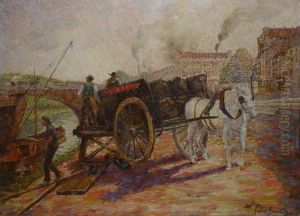Baudin Felix Paintings
Félix Baudin was a French painter and lithographer born in 1821 in Lyon, France. Not as widely recognized as some of his contemporaries, Baudin nonetheless contributed significantly to the 19th-century French art scene, primarily through his landscapes and historical scenes. He was part of the Romantic movement, which emphasized emotion and individualism, a departure from the classical art forms that preceded it.
Baudin trained at the École des Beaux-Arts in Lyon, where he was influenced by local artists and the rich artistic traditions of the region. Early in his career, he focused on lithography, a form of printmaking that allowed for the mass production of artworks, making his pieces more accessible to the public. His lithographs often depicted landscapes and urban scenes, capturing the changing face of France during the 19th century.
As he matured as an artist, Baudin's focus shifted towards painting, where he continued to explore themes of nature and history. His works are characterized by their detailed realism and often contained allegorical elements, reflecting the Romantic fascination with the sublime and the majestic aspects of nature. Baudin's historical paintings, which sometimes depicted scenes from ancient history or mythology, were praised for their accuracy and depth of emotion.
Despite his contributions to French art, Félix Baudin never achieved the same level of fame as some of his peers. He exhibited his work at the Paris Salon, a prestigious art exhibition, but remained somewhat on the periphery of the French art world. After his death in 1883, his works were largely forgotten by the general public, only to be rediscovered by art historians and collectors in the late 20th and early 21st centuries. Today, Baudin's paintings and lithographs are appreciated for their beauty and historical value, offering insight into the artistic and cultural landscapes of 19th-century France.
